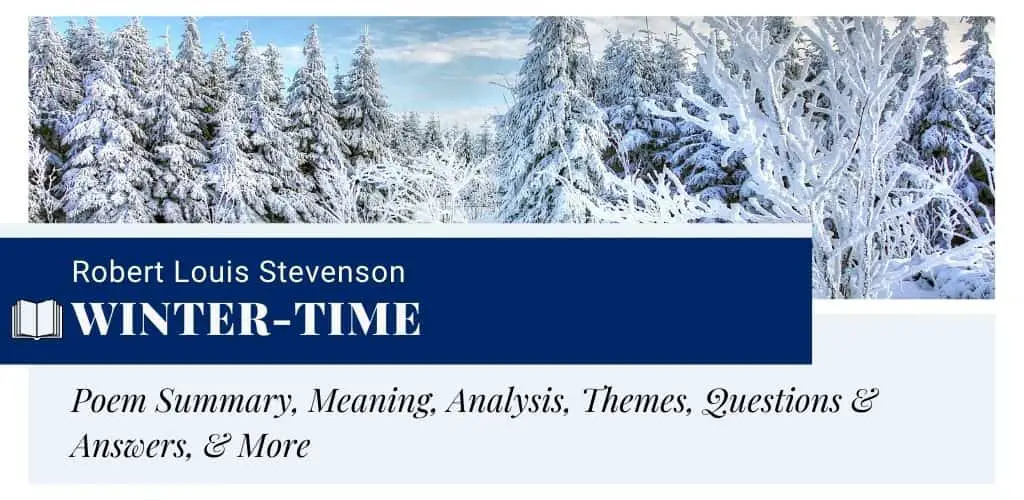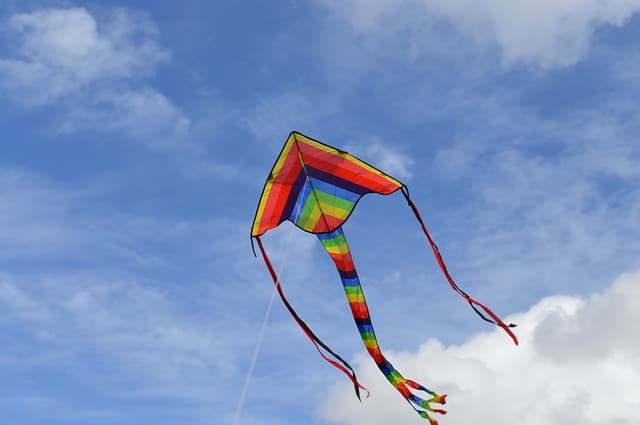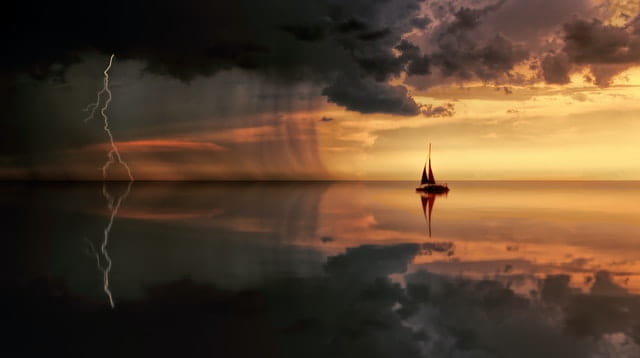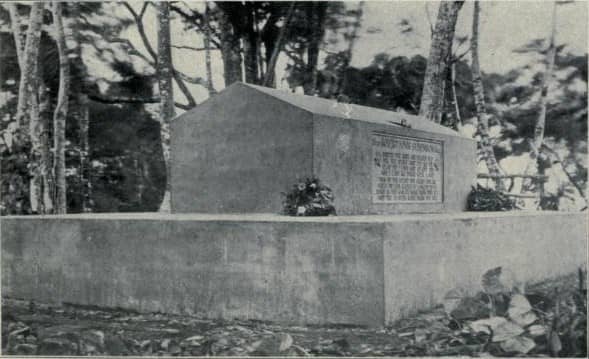Winter-Time by Robert Louis Stevenson
“Winter-Time” appears in Robert Louis Stevenson’s children’s book of poetry, A Child’s Garden of Verses. This poem vividly describes a winter scene and how a child enjoys the frosty beauty of nature. At the close of autumn, slowly and silently, winter approaches with its silvery snow, long nights, and chilling winds. For an adult, it is a melancholic time, filled with buried emotions of the past. In the case of a child, it is a time to explore the white fairy-like beauty of nature. This childish joy is reflected in this poem.
- Read the full text of “Winter-Time” below:
Winter-Time by Robert Louis Stevenson Late lies the wintry sun a-bed, A frosty, fiery sleepy-head; Blinks but an hour or two; and then, A blood-red orange, sets again. Before the stars have left the skies, At morning in the dark I rise; And shivering in my nakedness, By the cold candle, bathe and dress. Close by the jolly fire I sit To warm my frozen bones a bit; Or with a reindeer-sled, explore The colder countries round the door. When to go out, my nurse doth wrap Me in my comforter and cap: The cold wind burns my face, and blows Its frosty pepper up my nose. Black are my steps on silver sod; Thick blows my frosty breath abroad; And tree and house, and hill and lake, Are frosted like a wedding-cake. - from A Child's Garden of Verses (1885)

Summary
The poem “Winter-Time” begins with a description of the sun. Stevenson depicts how the sun lasts for a short time and sets with its blood-red orange hue. The speaker of this poem wakes up early in the morning while it is still dark. After waking up, he bathes and dresses to be ready for ready. He sits for a while beside the fireplace to warm his frozen bones. Then he sets out to explore the snowy region, with a sense of amusement in his heart. Before going out, the nurse wraps him up in a comforter and cap. Thereafter, he goes outside and wonders how everything is frosted like a “wedding-cake”.
Meaning
The title of the poem “Winter-Time” refers to the winter season. During this time, how a child goes out and explores the snow-covered nature is described here. The overall meaning of the text concerns a child’s appreciation for the winter season. Stevenson hints at the sense of joy in the child’s heart when he wanders about with a reindeer-sled. The cold wind burns his face and irritates his nose. Still, he stays there and enjoys the snow. It is the difference between a child and an adult. As we grow up this sense of wonder fades away. Whereas, a child goes out with a wandering heart irrespective of how harsh the condition is.
Form, Rhyme Scheme, & Meter
Stevenson’s “Winter-Time” consists of five quatrains or stanzas having four lines each. Each section concludes the idea with an end-stopped line. The rhyme scheme of the poem is AABB. It means the first and second, and the third and fourth lines rhyme together. In the first stanza, the rhyming pairs are “a-bed” and “head”, and “then” and “again”. Each line of the poem consists of four iambs. So, the overall poem is composed of a regular iambic tetrameter. Let’s have a look at the metrical scheme of the first stanza.
Late lies/ the win/-try sun/ a-bed,
A fros/-ty, fie/-ry sle/-epy-head;
Blinks but/ an hour/ or two;/ and then,
A blood/-red o/-range, sets/ a-gain.
Poetic Devices & Figurative Language
Stevenson uses the following poetic devices in “Winter-Time.”
- Personification: It occurs in the first stanza. Here, the poet personifies the sun with the ability to sleep. He also personifies the stars in the second stanza.
- Alliteration: The repetition of similar sounds can be found in “Late lies”, “frosty, fiery”, “Blinks but”, “cold candle”, “colder countries”, etc.
- Inversion: Stevenson uses this device to create a beautiful poetic rhythm. It occurs in “Late lies the wintry sun a-bed”, “At morning in the dark I rise”, etc.
- Metaphor: In “The cold wind burns my face”, there is a comparison between the “cold wind” and fire. Here, the effect of the cold wind is associated with the sensation of burning. There is another metaphor in “Its frosty pepper up my nose”.
- Polysyndeton: It occurs in “And tree and house, and hill and lake”.
- Simile: It can be found in the last line “Are frosted like a wedding-cake”. Here, the snow-covered nature is compared to a “wedding-cake”.
Themes
The main theme of “Winter-Time” is the beauty of wintertime. It also taps on the themes of childhood, innocence, joy, and nature. The central idea of the poem concerns a child’s reactions during winter. Stevenson showcases how the child wakes up early in the morning and sets out to explore the “colder countries”. It is a joy of seeing nature in a new shape that the child appreciates. The poet associates this idea with the beautiful depiction of winter. Besides, the theme of nature is present throughout the poem. Here, the poet depicts a kind of beauty that soothes, but chills.
Stanza-by-Stanza Analysis & Explanation
Stanza One
Late lies the wintry sun a-bed,
A frosty, fiery sleepy-head;
Blinks but an hour or two; and then,
A blood-red orange, sets again.
The poem “Winter-Time” is filled with rhythms, be it alliterating words or the rhyme at the end of lines. Stevenson wrote this poem in a measure that creates a long-lasting impression of sounds in readers’ minds. To begin with, if we focus on the beginning of the first three lines, the alliterating “l”, “f”, and “b” sounds can be found.
In this stanza, Stevenson personifies the sun. During the Arctic winters, the sun stays in the sky for a short period. The sun is described as someone who wakes up late from bed. For the poetic persona, it looks like a “frosty, fiery sleepy-head”. Here, the poet uses a personal metaphor in order to describe the sun as a “sleepy-head”. It means one who always feels like sleeping.
The cold winter makes the sun extremely sleepy. It can blink its eyes only for an hour or two. Thereafter, again, it goes to sleep. Here, the speaker hints at the time of sunset. During winter, it takes a “blood-red orange” hue.
Stanza Two
Before the stars have left the skies,
At morning in the dark I rise;
And shivering in my nakedness,
By the cold candle, bathe and dress.
In this poem, there is no description of the wintry night. Stevenson interestingly skips this part. He finds it more appropriate to connect his character’s disposition to that of the daytime. As the speaker of the poem is a child, he thinks, it would be apt not to bring in any darkness.
The speaker wakes up just before the stars have left the sky. Here, the poet uses “skies” instead of “sky” to point at the idea of vastness. In the morning while it is still dark, he gets up. The cold makes his naked body shiver. To get ready, he does not waste any time and gets ready for the day.
In the last line, the poet uses visual imagery. He uses the phrase “cold candle” to depict the visual as well as a tactile aspect of the image. Besides, the term “bathe” also gives a chilling sensation to readers.
Stanza Three
Close by the jolly fire I sit
To warm my frozen bones a bit;
Or with a reindeer-sled, explore
The colder countries round the door.
In the third stanza of “Winter-Time”, the speaker describes how he sits close to the “jolly fire”. Once again, Stevenson uses a personal metaphor in the quoted phrase. Here, the “fire” is described as being happy and cheerful. Actually, the fire makes the child cheerful by keeping him warm. He uses the hyperbolic phrase “frozen bones” to depict the degree of cold. It even freezes his bones.
However, the cold cannot keep him at home. In the following lines, he expresses his wish to go outside. He would ride a reindeer-sled and explore the colder regions around the door. Through these lines, he shows his desire for wanderlust. Like any other child, he also wants to enjoy the beauty of the snowy landscape. Just like the fire makes him cheerful, the snow makes him pleased.
Stanza Four
When to go out, my nurse doth wrap
Me in my comforter and cap;
The cold wind burns my face, and blows
Its frosty pepper up my nose.
When it is time to go out, his nurse dresses him in his comforter and cap. In this way, he gets ready and the exploration begins. He quickly goes out to drink the scenic beauty with his eyes. However, the process to enjoy the wintry magnificence comes with several challenges.
The speaker highlights the harshness of the weather outside. The wind is so cold that it feels like burning his face. This tactile imagery reveals how cold it is out there. When the speaker inhales the chilling air, it feels like someone has stuffed pepper up his nose.
However, all these problems are not discouraging to him. By describing how it feels when he goes out, the poet is hinting at the spirit of wanderlust in his heart. Though the weather is harsh, the child will not stop his journey in the middle.
Stanza Five
Black are my steps on silver sod;
Thick blows my frosty breath abroad;
And tree and house, and hill and lake,
Are frosted like a wedding-cake.
He keeps walking on the “silver sod”. The phrase “silver sod” is a metaphor of the snow-covered land. Stevenson hints at it by depicting its “silver” color. While walking, a “frosty breath” comes out of the speaker’s nose. When he exhales a breath, it forms vapor in contact with the cold wind outside. This vapor is described as “frosty breath”.
In the last two lines, the image of the winter landscape is described. Stevenson uses polysyndeton in the third line of this stanza. The conjunction “and” is repeated four times. It is used to depict how everything around the speaker is covered with now that includes but is not limited to the tree, house, hill, and lake.
The last line contains a comparison between the wintry landscape and a “wedding-cake”. It seems nature has turned into cake. The speaker is metaphorically enjoying this cake. For a child, snow is like a thing to cherish. He does so with all his heart.
Historical Context
The poem “Winter-Time” was first published in Robert Louis Stevenson’s first book of poetry A Child’s Garden of Verses. It was published in 1885. The volume was originally titled Penny Whistles. While publishing, the title was changed to the mentioned one. Stevenson was greatly influenced by a children’s book of 1880. He got the motivation of writing this volume after reading this work. The poems of this piece are written from a child’s point of view. So, in “Winter-Time”, the speaker is none other than a child who loves nature dearly. For him, snow is like a cake that he can enjoy only once a year.
Questions & Answers
R.L. Stevenson’s “Winter-Time” is all about a child’s love for the wintry landscape. In this poem, he wakes up way before the stars have left the sky. He quickly gets ready to explore all the regions covered with snow on his reindeer-sled.
In the first two stanzas, Stevenson describes the winter morning. At first, he describes how the sun blinks during the day for an hour and two. In the morning, due to its absence, it still remains dark outside.
The poem was written in the 1880s. It was first published in Stevenson’s poetry collection A Child’s Garden of Verses in 1885.
The fire is described with the personal metaphor “jolly”. It is actually a reference to the effect of the fire on the child’s mind. The fire makes him happy by keeping him warm. During chilling winter, warmth is what gives one happiness and makes his heart jolly.
The phrase “silver sod” is a metaphor of the snow-covered land. It gets covered with snow and looks like a silvery layer of sod.
Through these lines, the speaker describes the winter morning. When he wakes up in the morning, it is still dark outside. It is the time just before the stars leave the sky. So, the speaker wakes up very early in the morning.
In these lines, the poet describes how everything around the speaker is covered with snow. It includes but is not limited to the tree, house, hill, and lake. For the speaker, the winter landscape is like a “wedding-cake” of nature. A “wedding-cake” is covered with white cream. So, there is a similarity between the color of a wedding cake and the winter landscape.
Explore More Poems from A Child’s Garden of Verses
Similar Poems about the Winter
- “The First Snowfall” by James Russell Lowell — This heart-touching poem is about the death of the poet’s daughter.
- “Equinox” by Elizabeth Alexander — This poem is about the coming of winter.
External Resources
- About A Child’s Garden of Verses (1885) — Read about the history of its publication and the best-known poems from this collection.
- Full Text of A Child’s Garden of Verses: Selected Poems (1913) — Explore more Stevenson poems published in this volume.
- Robert Louis Stevenson’s Life — Read about the poet’s life.
- About Robert Louis Stevenson — Explore more about the poet’s life and his works.
- Poet Profile & Poems of R. L. Stevenson — Learn more about the poet and read some of his best-known poems.





